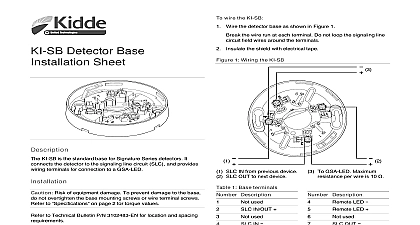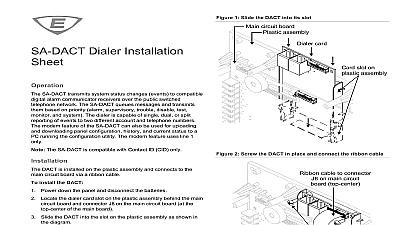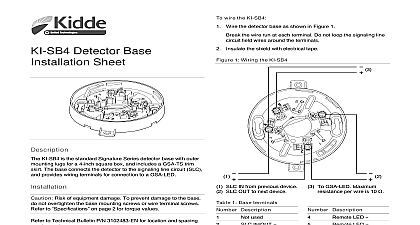Kidde 3101069-EN R005 FX-PDD Duct Smoke Detector Installation Sheet

File Preview
Click below to download for free
Click below to download for free
File Data
| Name | kidde-3101069-en-r005-fx-pdd-duct-smoke-detector-installation-sheet-9458160372.pdf |
|---|---|
| Type | |
| Size | 1.58 MB |
| Downloads |
Text Preview
Duct Smoke Installation Sheet FX PDD Duct Smoke Detector is designed for use in duct where temperatures can exceed standard detector device address is set using the two rotary switches located on front of the unit One device address is required installations where the controls and indicators are hidden from a remote test station or an LED indicator can be connected to detector to provide these functions settings following jumper settings determine the operation of the See Figure 6 for proper jumper location 1 JP3 jumper settings the detector for alarm latching the detector for supervisory is the factory default setting operation LEDs visible from the front of the detector show its status when the detector is in the alarm state intermittently when the detector is in normal state the detector is in the alarm active 2 LEDs LED LED 2020 Carrier The duct smoke detector is not intended as a substitute for open protection This detector does not operate without electrical power As fires cause power interruption discuss further safeguards the local fire protection specialist The duct smoke detector does not operate as designed outside the listed electrical and environmental specifications The duct smoke detector does not sense smoke unless the system is operating and the sensor cover is installed The duct smoke detector may not operate as designed unless in accordance with these instructions and all applicable and local codes as determined by the local authority jurisdiction Read these instructions thoroughly before installing Refer to Bulletin P N 3101107 for additional information regarding instructions guidelines ensure correct operation install the duct detector using the guidelines the duct smoke detector on a flat section of HVAC duct six and ten duct widths from any bends or obstructions supply side detectors at a point downstream from the fan and after the air filter return side detectors at a point before the return air is diluted by outside air the duct air velocity order to verify the airflow direction and velocity air must be through the HVAC system verify the duct air velocity Drill a small hole at the point where the duct smoke detector is installed Using the SD VTK Air Velocity Test Kit and a suitable air meter verify that the air velocity in the HVAC duct falls the specified operating range of the detector and note direction the air flows the air velocity does not fall within the specified range relocate detector and seal the hole in the HVAC duct Refer to Bulletin P N 3101107 for additional information to installation locations 6 3101069 EN REV 005 ISS 19OCT20 an appropriate sampling tube Select a sampling tube that extends at least two thirds across width of the duct Refer to Table 3 below For duct widths greater than 36 inches use a sampling tube that longer than the width of the duct Sampling tubes are available in the following lengths 2 Sampling tube installation in 3 Sampling tubes assemble the detector Assemble the duct smoke detector as shown in Figure 1 Rotate the air sampling tube so the inlet holes face the direction in airflow The sampling tube is normally installed from the rear but it can be installed from the front of the detector as shown in 2 This method requires that you remove the detector 1 Duct detector assembly Exhaust tube socket Sampling tube socket Detector Coupling Sampling tube Plug Thick gasket Thin gasket Exhaust tube Sampling tube socket Detector Sampling tube fully assembled install the detector Attach the drill template to the HVAC duct at the desired location Drill or punch the mounting holes where indicated Remove any rough edges from the holes When using an air sampling tube that is longer than the width of duct a 3 4 in hole on the opposite side of the duct for the to pass through the tube so that approximately one inch of the tube through the duct Seal the opening around the with an approved duct sealant as shown in Figure 3 Support sampling tubes longer than 36 inches at both of the duct See Figure 3 Mount the duct smoke detector on the HVAC duct and secure it the two sheet metal screws provided See Figure 4 Verify that all field wiring is free of opens shorts and ground Make all wiring connections as shown in Figure 6 Set the module address as follows Use a screwdriver to adjust the two rotary switches on the of the module See Figure 5 Set the TENS rotary switch 0 through 12 for the 10s and digit Set the ONES rotary switch for the 0 through 9 digit example for device address 21 set the TENS rotary switch 2 and then set the ONES rotary switch to 1 a list of detector addresses see Table 4 on page 3 Set jumper JP3 to the appropriate position See Table 1 and 6 Verify that the air pressure differential value falls within the operating range of the detector in accordance with specified in the air pressure differential page 4 After completing the installation of the duct smoke detector test detector in accordance with procedures specified in duct smoke detector on page 5 to ensure it is operating 6 3101069 EN REV 005 ISS 19OCT20 5 Address switches 6 4 5 9 Insert screwdriver here in accordance with NFPA 72 and CAN ULC S524 Be sure to the polarity of the terminals on the terminal block as shown Figure 6 4 Detector address to 64 to 127 point control panel point control panel 3 Sampling tube support HVAC duct Exhaust tube Detector Sampling tube 36 in 0.92 m Airflow Plug Sealant 4 Duct detector installation Airflow HVAC duct Detector 10 sheet metal screws 2X Sampling tube 3101069 EN REV 005 ISS 19OCT20 6 6 Duct detector wiring 3 4 Auxiliary equipment Power limited unless connected to a Remote alarm active indicator See on page 5 for a of available model numbers Connect only one remote test station or LED indicator to the Wiring is unsupervised Maximum wire resistance is 10 wire Remote test station See on page 5 for a list of model numbers Power indicator Alarm Indicator JP3 shown in the factory default position for supervisory mode Alarm position Supervisory position source If the source is nonpower limited the power limited mark and maintain a minimum of in 6.4 mm space from power limited wiring For other methods see enclosure and bracket installation sheets maintain separation of power limited and nonpower limited The wire size must be capable of handling fault current from nonpower limited source or type FPL FPLR FPLP or permitted substitute cables that the power limited cable conductors extending beyond jacket are separated by a minimum of 0.25 in 6.4 mm space by a


